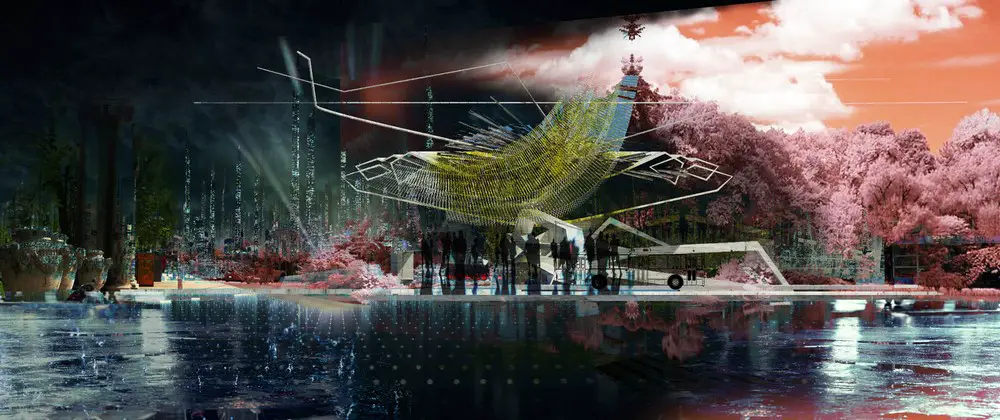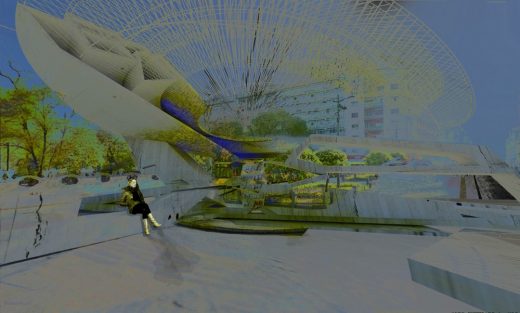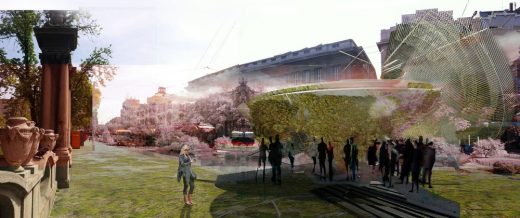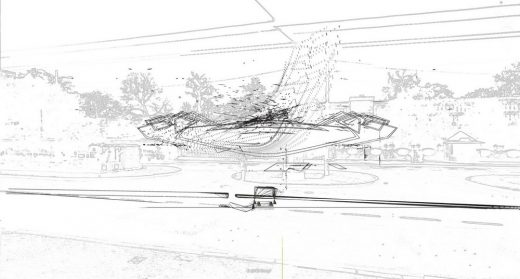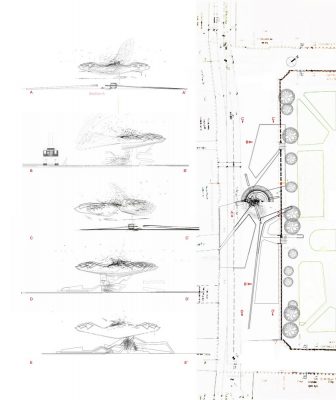Piezoelectric Trolleybus Gardens, Architecture, News, Design Proposal Images
Piezoelectric Trolleybus Gardens Design
Architectural Concept Project design by Margot Krasojevic Architect
6 Jul 2016
Piezoelectric Trolleybus Gardens Proposal
Design: Margot Krasojevic
Trolleybus Central Terminus Studentski Trg.
Trolleybuses are electric vehicles which makes them more environmentally friendly than fossil fuel or hydrocarbon-based vehicles when implemented in the city. The power is not free as it has to be produced at centralised power plants, however, it is produced more efficiently making it more responsive to pollution control rather than individual vehicles exhausting noxious gases at street level.
A trolleybus draws power from overhead wires using spring-loaded trolley poles made from wood and metal, which complete the electrical circuit by transferring electricity from a “live” overhead wire to the control and the electric traction motors of the trolley bus., a type of current collector.
Each trolley pole, trolley bus elevation, tire and overhead wire will contain 3d printed piezoelectric cells generate electrical energy from pressure deformation in the semiconductors for on-board electronics. The city of Belgrade uses trolleybuses as one of it’s major modes of public transport with an extensive route stretching across the city and the suburbs.
A further advantage of trolleybuses is that they can generate electricity from kinetic energy while braking, this process, known as regenerative braking, is addressed in the design criteria for the trolleybus gardens terminal, the design will be used to store and release electrical energy as and when necessary.
The project uses printed piezoelectric cells applied to the main body of the helix structure to generate electricity from trolleybus pulses as they pass through stations within the city, The steel frame concrete clad helix has a series of aluminum consolidated carbon nano-tubes which increase the heat and electrical conductivity of the material embedded within it’s structure. The aluminum insert frames are printed with piezoelectric crystals which generate electricity from the air flow and pressure exerted from the trolleybus and it’s overhead wire movement.
The piezocells are stacked within the design’s elevated section in order to increase the energy output, the folded cross section of elevated walls further increase the vibration of the trolley-poles and their effects on deforming the semi-conductor cells, in turn amplifying the output. ; environmental changes wind and rain also vibrate the steel wire cluster which connects the project to existing overhead wires, these vibrations/reverberations amplify the piezoelectric cell displacements as a result of the kinetic movement; the design acts as an electrical amplifier, providing street lighting, Internet WiFi access for immediate neighborhoods as well as offer an adaptive power port, commuters will be able to charge mobiles and smart cars at these trolleybus station gardens.
Using electrical pulses from kinetic movement and rain, the vibrations also encourage plant growth in the city centerer as piezoelectric cells generate electric current to stimulate root growth, similar to solar cells and photosynthesis, there is a park next to the terminal which will also benefit by powering the irrigation and sprinklers.
Piezoelectric materials generate electrical energy when subjected to mechanical strain. Power-generation devices based on such materials have been applied in vibrational-energy harvesting.
Benders made of PZT (lead zirconate titanate, the most common piezoelectric ceramic material) attached to a tire as well as the overhead aluminum composite wire cluster can deliver a high-power output, it is important to cover as much of a surface area as possible with PZT benders, providing a reliable and continuous source of energy.
The trolleybus garden acts as a capacitor and transistor to step up the harnessed electrical energy, the architecture acts as a rectifier transforming AC current from the piezoelectric cells to DC current before it can be cached in the capacitor ready for distribution.
The architecture supports the idea that energy harvesting, smart materials and systems need to be an inherent part of the design process, dictating the terms of the architectural design criteria rather than referring to sustainable technology as a polite afterthought. This project follows the Piezoelectric Playground also in belgrade.
Piezoelectric Trolleybus Gardens images / information from Margot Krasojevic 060716
Margot Krasojevic Architect on e-architect
Location: London, England, UK
Margot Krasojevic – Recent Designs
Hydroelectric Waterfall Prison – Architectural Concept

image from architect
Margot Krasojevic Design – Hydroelectric Waterfall Prison
The Ordos MU US Desert Temple, Inner Mongolia, Peoples Republic of China

image : Dr. Margot Krasojevic
Buddhist Temple Ordos
A Dance School building on e-architect:
Siobhan Davies Studios, London
Design: Sarah Wigglesworth Architects

photos © Richard Bryant
Dance School Architecture
Dance Base, Edinburgh, Scotland
Design: Malcolm Fraser Architects

image © Isabelle Lomholt
National Dance Centre – Stirling Prize nominee 2002
Comments / photos for the Piezoelectric Trolleybus Gardens Design
page welcomeWebsite: Margot Krasojevic

